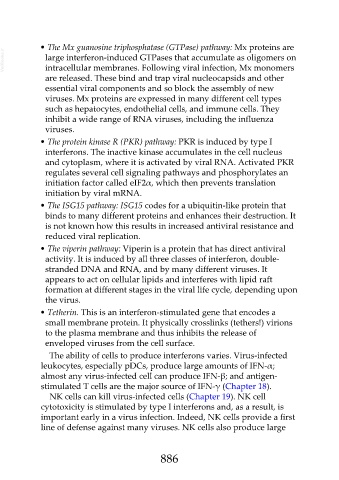Page 886 - Veterinary Immunology, 10th Edition
P. 886
• The Mx guanosine triphosphatase (GTPase) pathway: Mx proteins are
VetBooks.ir large interferon-induced GTPases that accumulate as oligomers on
intracellular membranes. Following viral infection, Mx monomers
are released. These bind and trap viral nucleocapsids and other
essential viral components and so block the assembly of new
viruses. Mx proteins are expressed in many different cell types
such as hepatocytes, endothelial cells, and immune cells. They
inhibit a wide range of RNA viruses, including the influenza
viruses.
• The protein kinase R (PKR) pathway: PKR is induced by type I
interferons. The inactive kinase accumulates in the cell nucleus
and cytoplasm, where it is activated by viral RNA. Activated PKR
regulates several cell signaling pathways and phosphorylates an
initiation factor called eIF2α, which then prevents translation
initiation by viral mRNA.
• The ISG15 pathway: ISG15 codes for a ubiquitin-like protein that
binds to many different proteins and enhances their destruction. It
is not known how this results in increased antiviral resistance and
reduced viral replication.
• The viperin pathway: Viperin is a protein that has direct antiviral
activity. It is induced by all three classes of interferon, double-
stranded DNA and RNA, and by many different viruses. It
appears to act on cellular lipids and interferes with lipid raft
formation at different stages in the viral life cycle, depending upon
the virus.
• Tetherin. This is an interferon-stimulated gene that encodes a
small membrane protein. It physically crosslinks (tethers!) virions
to the plasma membrane and thus inhibits the release of
enveloped viruses from the cell surface.
The ability of cells to produce interferons varies. Virus-infected
leukocytes, especially pDCs, produce large amounts of IFN-α;
almost any virus-infected cell can produce IFN-β; and antigen-
stimulated T cells are the major source of IFN-γ (Chapter 18).
NK cells can kill virus-infected cells (Chapter 19). NK cell
cytotoxicity is stimulated by type I interferons and, as a result, is
important early in a virus infection. Indeed, NK cells provide a first
line of defense against many viruses. NK cells also produce large
886

